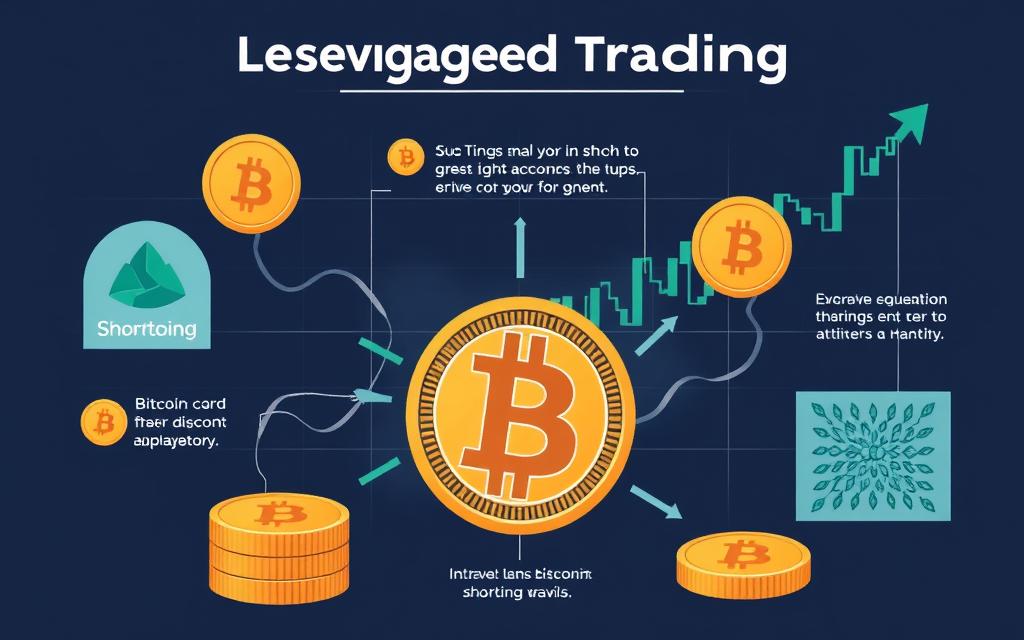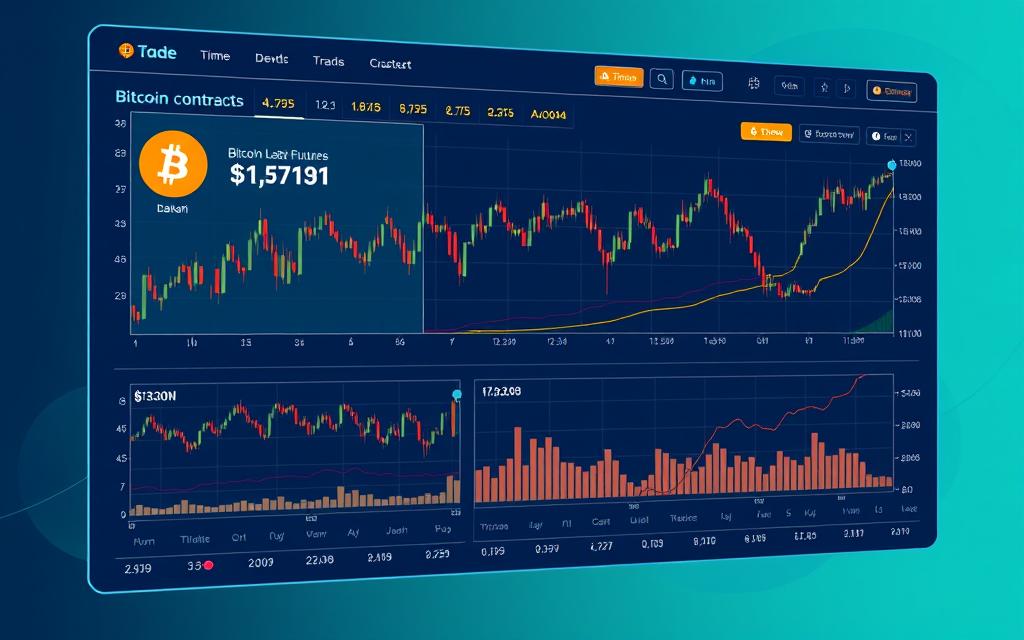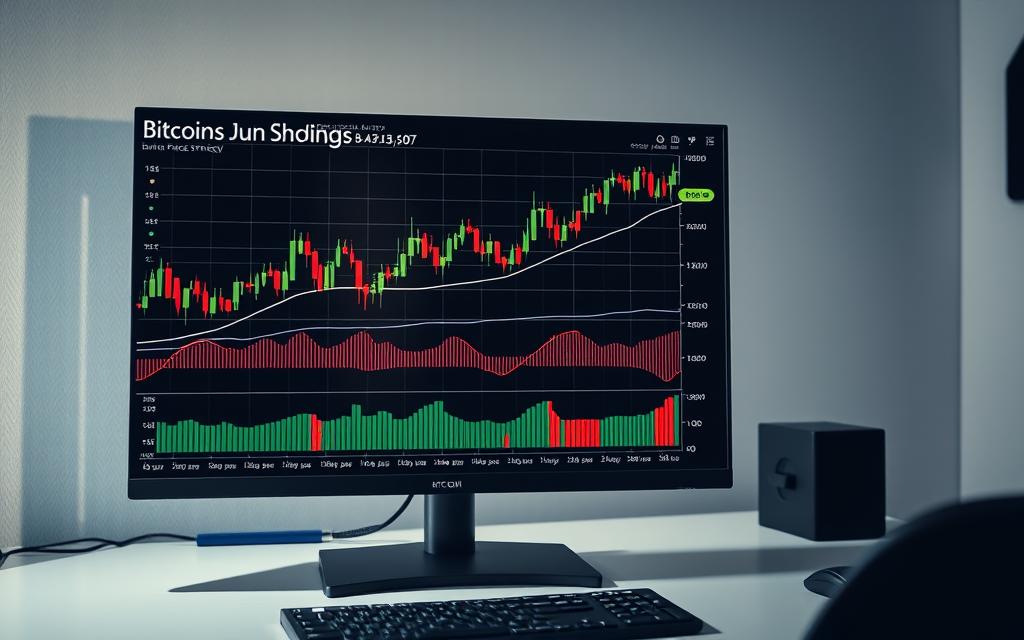Table of Contents
Trading in the cryptocurrency market can be highly volatile, and Bitcoin is no exception. For traders looking to capitalize on downward price movements, shorting Bitcoin can be a viable strategy.
Shorting involves borrowing an asset, selling it at the current market price, and then buying it back later at a hopefully lower price. This strategy requires a deep understanding of trading and the associated risks.
In this guide, we’ll explore the fundamental mechanics of shorting and various methods for executing this strategy, including traditional exchange-based approaches and leveraged trading products.
Understanding Bitcoin Shorting Basics
Shorting Bitcoin is a trading strategy that involves selling the cryptocurrency at a high price with the intention of buying it back later at a lower price. This approach is contrary to the traditional “buy low, sell high” strategy, as it involves selling high and buying low.
What Does Shorting Bitcoin Mean?
Shorting Bitcoin fundamentally involves borrowing Bitcoin from a broker or exchange, immediately selling it at the current market price, and then repurchasing it later to return to the lender. The goal is to profit from the difference in price between the sale and the repurchase. This process requires a deep understanding of the market dynamics and the factors influencing Bitcoin’s price.
| Steps | Description |
|---|---|
| 1. Borrow Bitcoin | Borrow a certain amount of Bitcoin from a broker or exchange. |
| 2. Sell at Market Price | Sell the borrowed Bitcoin at the current market price. |
| 3. Repurchase | Repurchase the same amount of Bitcoin at a later time, ideally at a lower price. |
| 4. Return and Profit | Return the borrowed Bitcoin to the lender and keep the profit made from the price difference. |
The Psychology Behind Shorting Cryptocurrency
The psychology behind shorting cryptocurrency is complex, requiring traders to have emotional discipline and conviction in their market analysis. It involves going against the prevailing market sentiment, which can be challenging. Traders must be prepared to withstand temporary price increases without panicking and closing their positions prematurely.
Why Traders Choose to Short Bitcoin
Bitcoin shorting is a popular strategy among traders who seek to profit from market declines and asset revaluation. This approach allows traders to capitalize on their predictions of downward trends in the Bitcoin price.
Profiting from Market Downturns
Traders establish short positions on Bitcoin to profit from market downturns. When the price drops, these positions yield significant returns, making it a straightforward motivation for shorting.
Hedging Existing Cryptocurrency Positions
Shorting Bitcoin also serves as a hedging strategy for traders with existing cryptocurrency holdings. By opening short positions, they can offset potential losses in their portfolio when the market declines.
Capitalizing on Bitcoin’s Volatility
Bitcoin’s notorious price volatility creates opportunities for traders to capitalize on rapid price swings. This volatility makes shorting a valuable tool in their trading arsenal, allowing them to profit from both upward and downward movements.

Traders short Bitcoin for multiple reasons, including speculation that the asset is overvalued or exists in a price bubble. By understanding these motivations, traders can make informed decisions about their shorting strategies.
Evaluating if Shorting Bitcoin is Right for You
Before diving into Bitcoin shorting, it’s crucial to assess whether this trading strategy aligns with your financial goals and risk tolerance. Shorting Bitcoin involves unique challenges and risks that require careful consideration.
Risk Tolerance Assessment
Traders must honestly assess their risk tolerance before shorting Bitcoin, as short positions face unlimited loss potential if prices rise significantly. A thorough evaluation of your risk appetite is crucial to avoid substantial trading losses. According to a study, many traders underestimate the risks associated with shorting cryptocurrencies, leading to unexpected losses.
- Evaluate your ability to withstand potential losses.
- Consider your experience level in trading complex financial instruments.
- Assess your psychological readiness to maintain conviction in your analysis despite temporary price movements against your position.
Capital Requirements
The capital requirements for shorting Bitcoin vary significantly depending on the method chosen. For instance, exchange-based shorting typically requires substantial collateral, while leveraged products may allow trading with smaller initial capital but amplify both gains and losses. Traders should carefully evaluate their capital availability and the implications of different shorting methods.
| Shorting Method | Capital Requirement | Risk Level |
|---|---|---|
| Exchange-Based Shorting | Substantial Collateral | High |
| Leveraged Products (e.g., CFDs) | Smaller Initial Capital | Very High |
As highlighted by a trading expert, “Understanding your capital requirements and risk exposure is key to successful Bitcoin shorting.”
How to Short Bitcoin Through Cryptocurrency Exchanges
Traders can short Bitcoin by utilizing dedicated cryptocurrency exchanges. This method involves borrowing Bitcoin from a broker or another willing lender and selling it immediately, with the expectation of buying it back later at a lower price.

Popular Exchanges for Bitcoin Shorting
Several cryptocurrency exchanges offer dedicated shorting functionality, including Kraken, Bitfinex, and BitMEX. These exchanges allow traders to borrow Bitcoin directly on their platform for short selling purposes.
- Cryptocurrency exchanges like Kraken, Bitfinex, and BitMEX offer dedicated shorting functionality.
- Traders should compare borrowing fees, commission structures, and platform reliability.
Step-by-Step Process for Exchange Shorting
The exchange-based shorting process involves several steps: opening an account, completing identity verification, depositing collateral, borrowing Bitcoin, selling it, and later repurchasing it at hopefully lower prices.
- Opening an account and completing identity verification.
- Depositing collateral to cover potential losses.
- Borrowing Bitcoin from the exchange or other users.
Leveraged Trading Methods for Shorting Bitcoin

Leveraged trading platforms enable traders to short Bitcoin by taking positions on price movements without directly owning the cryptocurrency. This method involves using financial derivatives such as CFDs (Contracts for Difference) and spread betting to speculate on Bitcoin’s price declines.
CFDs (Contracts for Difference)
CFDs represent a popular leveraged method to short Bitcoin without owning the underlying asset. Traders can speculate on price movements with a smaller initial capital outlay. When using CFDs to short Bitcoin, traders open a position that profits from price decreases, with gains or losses calculated based on the difference between entry and exit prices multiplied by the position size.
Leverage in CFD trading can significantly amplify returns when correctly predicting Bitcoin price movements. However, it equally magnifies losses when predictions are incorrect, increasing the risk profile of the trading strategy. For more information on shorting Bitcoin, visit Investopedia.
Spread Betting Options
Spread betting offers another leveraged approach to short Bitcoin, with potential tax advantages in certain jurisdictions as profits may be exempt from capital gains tax or stamp duty. Like CFDs, spread betting involves taking a position on the price movement of Bitcoin without owning the asset.
Both CFDs and spread betting platforms typically provide additional risk management tools like guaranteed stop-losses that can help traders define their maximum potential loss when shorting Bitcoin with leverage. By understanding and utilizing these tools, traders can better manage their exposure and potential losses in margin trading.
Using Bitcoin Futures to Short the Market

Bitcoin futures contracts enable traders to take a short position on the Bitcoin market. This involves agreeing to sell Bitcoin at a predetermined price on a specific future date, regardless of the actual market price at that time.
How Bitcoin Futures Contracts Work
Bitcoin futures are a type of financial contract that allows traders to buy or sell Bitcoin at a specified price on a particular date. These contracts were initially designed to help traders manage price fluctuations in commodity markets, but they have since been adapted for various asset classes, including cryptocurrencies like Bitcoin.
When a trader enters into a Bitcoin futures contract, they commit to buying or selling a specified quantity of Bitcoin at an agreed-upon price on a specific date. This can be used to short the market by selling contracts with the expectation of buying them back at a lower price before expiration.
Setting Up Your First Futures Short Position
To set up a futures short position, traders typically select an appropriate expiration date, determine their position size based on available margin, and place a sell order at the market or limit price. Active management of the position is crucial until it is closed or expires.
Major exchanges offering Bitcoin futures include CME Group, Bakkt, and various cryptocurrency exchanges like Binance and FTX. Each exchange has different contract specifications, margin requirements, and settlement procedures.
Options Trading as a Bitcoin Shorting Strategy

For those looking to short Bitcoin, options trading offers a flexible and potentially lucrative approach. Options contracts give traders the right, but not the obligation, to buy or sell Bitcoin at a specified price within a specific date range. This method is particularly appealing to advanced traders due to its complexity and the use of leverage.
Put Options Explained
Put options represent a straightforward way to short Bitcoin, granting traders the right to sell BTC at a predetermined price (strike price) before the option’s expiration date. When purchasing put options, traders pay a premium, which is their maximum possible loss, while their potential profit is substantial if the BTC price falls significantly below the strike price.
Strike Options and UpDown Options
Strike Options, available on the Crypto.com App, simplify the contract trading experience by turning predictions on BTC price movements into ‘yes/no’ propositions. Traders can also utilize UpDown Options, a derivative that automatically terminates when BTC hits predetermined price levels, offering built-in risk management. These options trading strategy allows for more sophisticated shorting approaches.
By understanding and leveraging these options trading tools, traders can develop a robust strategy for shorting Bitcoin, managing risk, and potentially capitalizing on market downturns.
Margin Trading to Short Bitcoin

Margin trading offers a powerful way to short Bitcoin by leveraging borrowed funds. This strategy allows traders to open a Bitcoin position using collateral without paying the full amount upfront.
Understanding Leverage and Margin Requirements
Understanding margin requirements is crucial when shorting Bitcoin. Different platforms require different minimum deposits, typically ranging from 10-50% of the total position value, to open and maintain margin positions. Leverage in margin trading is expressed as a ratio (e.g., 5:1, 10:1, 20:1) and determines how much your gains and losses are multiplied.
Managing Margin Calls
Margin calls occur when losses on a short position reduce your account equity below required maintenance margin levels. To avoid liquidation, traders must either add more funds or have their positions automatically liquidated. Effective margin management includes using lower leverage, maintaining buffer funds, setting stop-loss orders, and monitoring position performance.
By understanding and managing margin trading effectively, traders can potentially amplify their gains when shorting Bitcoin. However, it’s crucial to be aware of the risks involved and to manage positions carefully.
Technical Analysis Strategies for Bitcoin Shorting
To successfully short Bitcoin, traders often rely on technical analysis strategies. This approach involves reviewing historical BTC price charts and using various technical indicators to predict future market movements.
Key Indicators for Shorting Opportunities
Several key indicators can help identify potential shorting opportunities. Moving averages, particularly the 50-day and 200-day SMAs, are crucial for identifying downtrends and potential entry points. The MACD (Moving Average Convergence Divergence) indicator serves as a powerful momentum tool, with bearish crossovers and divergences often signaling potential price declines. Additionally, Relative Strength Index (RSI) readings above 70 can indicate overbought conditions, potentially presenting shorting opportunities when the indicator begins to decline.

Reading Chart Patterns for Downtrends
Chart patterns provide visual confirmation of potential downtrends. Patterns like head and shoulders, double tops, and descending triangles offer specific price targets and risk management levels for short trades. Volume analysis plays a critical role in confirming BTC shorting signals, as increasing volume during price declines typically indicates stronger bearish sentiment and more sustainable downtrends.
Risk Management When Shorting Bitcoin
To succeed in shorting Bitcoin, one must prioritize risk management. Shorting Bitcoin involves significant risks due to the cryptocurrency’s volatility and the potential for unlimited losses. Effective risk management strategies are essential to mitigate these risks.
Setting Stop-Loss and Take-Profit Levels
Setting stop-loss and take-profit levels is critical in managing risk. A stop-loss order automatically closes a short position when the price reaches a certain level, limiting potential losses. Take-profit levels, on the other hand, allow traders to lock in profits when the price reaches a predetermined level. By setting these levels, traders can create a favorable risk-reward ratio.
- Stop-loss orders help limit potential losses by automatically closing a short position at a predetermined price level.
- Take-profit levels enable traders to lock in profits when the markets move in their favor.
Position Sizing and Capital Allocation
Position sizing is another crucial aspect of risk management. Experienced traders typically limit each short position to a small percentage (1-5%) of their total trading capital. This approach helps manage risk exposure and prevents significant losses. Diversification across multiple shorting methods or timeframes can also help mitigate risk in volatile markets.

Conclusion: Approaching Bitcoin Shorting Responsibly
To succeed in shorting Bitcoin, traders must combine knowledge of market dynamics with a robust risk management framework.
Shorting Bitcoin offers significant profit potential during market downturns, but beginners should start with small position sizes and lower leverage until gaining experience with the unique dynamics of cryptocurrency markets. Continuous education about Bitcoin market fundamentals, technical analysis, and evolving shorting methodologies is essential for developing effective and adaptable shorting strategies.
Responsible Bitcoin shorting requires strict adherence to risk management principles, including predetermined stop-losses, appropriate position sizing, and never risking more capital than you can afford to lose. Emotional discipline is also crucial, as it enables traders to follow their trading plans even when short-term market movements create psychological pressure.
By combining knowledge, risk management, and emotional discipline, traders can navigate the complexities of Bitcoin trading and potentially capitalize on market opportunities.
FAQ
What are the risks associated with shorting Bitcoin?
Shorting Bitcoin involves significant risks, including potential losses if the market moves against your position, margin calls, and the risk of being unable to buy back the asset at a favorable price.
How do I choose the right cryptocurrency exchange for shorting Bitcoin?
When selecting an exchange, consider factors such as leverage offered, fees, margin requirements, and the exchange’s reputation for reliability and security.
What is the difference between shorting Bitcoin through futures contracts and options?
Futures contracts obligate you to buy or sell Bitcoin at a set price on a specific date, while options give you the right, but not the obligation, to buy or sell at a predetermined price.
How does margin trading work when shorting Bitcoin?
Margin trading involves borrowing funds from a broker or exchange to increase your trading position, potentially amplifying gains but also increasing the risk of significant losses and margin calls.
What are some key indicators for identifying opportunities to short Bitcoin?
Traders often use technical analysis indicators such as moving averages, Relative Strength Index (RSI), and chart patterns to identify potential downtrends and shorting opportunities.
How can I manage my risk when shorting Bitcoin?
Effective risk management involves setting stop-loss and take-profit levels, position sizing, and allocating capital wisely to limit potential losses.
What are the benefits of using technical analysis when shorting Bitcoin?
Technical analysis can help traders identify trends, predict potential price movements, and make informed decisions about when to enter and exit short positions.
Can I short Bitcoin on any cryptocurrency exchange?
Not all exchanges offer shorting capabilities or the same level of leverage. It’s essential to choose an exchange that meets your trading needs and offers the necessary tools for shorting.









